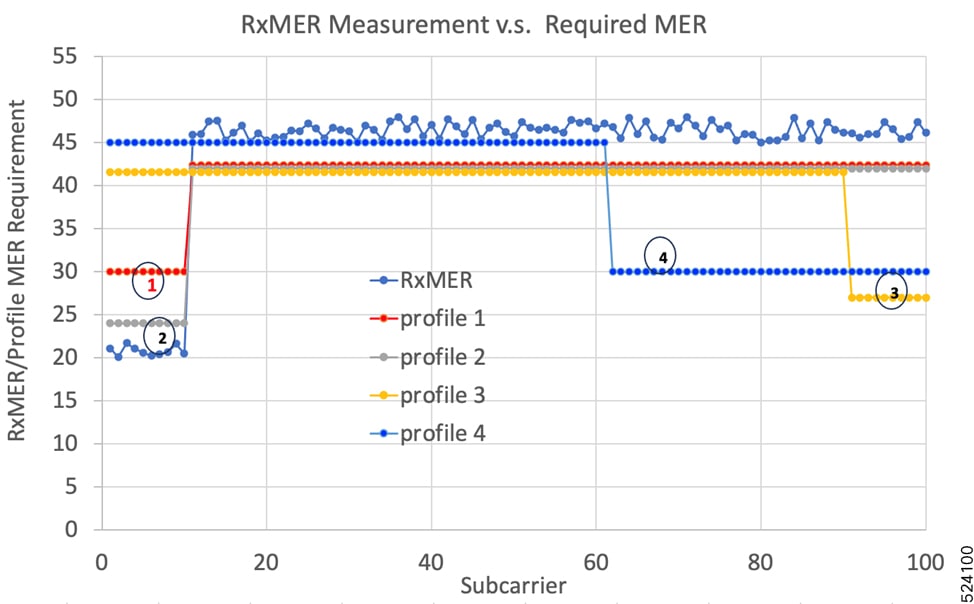Table 4. Feature History
|
Feature Name
|
Release Information
|
Feature Description
|
|
Clearing OFDM Unfit Profile List
|
Cisco IOS XE Dublin 17.12.1z
|
CMTS devices clear all the profiles from the unfit profile list upon receiving a Dynamic Bonding Change Response (DBC-RSP)
message from the cable modem.. The profiles are cleared as long as they are not present in the Dynamic Bonding Change Request
(DBC-REQ) list of Profiles.
This feature ensures that good profiles do not remain in the unfit list for a longer duration.
|
When a cBR-8 router reports an OFDM profile failure (CM-STATUS event 16) for a profile, the OFDM profile management module
on CMTS moves the faulty profile to the unfit list.
When CMTS sends a Dynamic Bonding Change Request (DBC-REQ) message to update the list of profiles on the cBR-8 router, the
cBR-8 router sends the Dynamic Bonding Change Response (DBC-RSP) message in response. The DBC messages are system defined
MAC management messages which handle changing of channel assignments and Downstream Service Identifiers (DSID).
CMTS clears the profiles from the unfit profile list, after receiving a Dynamic Bonding Change Response (DBC-RSP) message
as long as they are not present in the list of profiles in Dynamic Bonding Change Request (DBC-REQ) message.
The unfit profile list does not have to meet either of these conditions to be cleared:
Use the show cable modem [ ip-address | mac-address ] prof-mgmt downstream command to verify if the unfit profile list is clear.
This feature ensures that good profiles don’t remain in the unfit list and ensures timely clearing up of the unfit list.
The following example shows the partial output of the show cable modem XXXX.XXXX.XXXX prof-mgmt downstream verbose after the CM status event 16 for the current profile 2 is generated in releases before Cisco IOS XE Dublin 17.12.1z:
router# show cable modem XXXX.XXXX.XXXX prof-mgmt downstream verbose
.
.
.
DCID : 159
Configured Profile(s) : 0 1 2 3 4 5 6
Profile(s) in REG-RSP-MP : 0 1 2 3
Profile(s) in DBC-REQ : 0 3 4 5
Current profile : 4 [512-QAM..2048-QAM]
Percentages of ideal BL vs Curr Prof : 99 (better) 0 (equal)
External Profile Management (PMA) : Inactive
Downgrade profile : 0
Recommend profile : 1
unfit profile(s) : 1 2
Recommend profile (Expired) : N/A
unfit profile(s) (Expired) : N/A
Flow to Profile override : Inactive
.
.
.
In this output, profile 2 moves to the unfit profile list and profile 4 moves to the current profile. As profile 4 isn’t on a cable modem, DBC-REQ is triggered. The unfit profile list currently has profiles 1 and 2 and the DBC-REQ list has profiles 0, 3, 4 and 5.
The unfit profiles 1 and 2 in this case remain in the unfit profile list until the unfit timer expires or until CM status event 24 is received from
the cable modem. These Profiles can’t be used by the cable modem until they are cleared from the unfit profile list.
The following example shows the partial output of the show cable modem XXXX.XXXX.XXXX prof-mgmt downstream verbose after the CM status event 16 for the current profile 2 is generated in Cisco IOS XE Dublin 17.12.1z and later.
router# show cable modem XXXX.XXXX.XXXX prof-mgmt downstream verbose
.
.
.
DCID : 159
Configured Profile(s) : 0 1 2 3 4 5 6
Profile(s) in REG-RSP-MP : 0 1 2 3
Profile(s) in DBC-REQ : 0 3 4 5
Current profile : 4 [512-QAM..2048-QAM]
Percentages of ideal BL vs Curr Prof : 99 (better) 0 (equal)
External Profile Management (PMA) : Inactive
Downgrade profile : 0
Recommend profile : 1
unfit profile(s) : N/A
Recommend profile (Expired) : N/A
unfit profile(s) (Expired) : N/A
Flow to Profile override : Inactive
.
.
.
In this output, profile 2 moves to the unfit profile list and profile 4 moves to the current profile. As profile 4 isn’t on a cable modem, DBC-REQ is triggered. Profile 1 and 2 are cleared from the unfit profile list since profiles 1 and 2 aren’t in the DBC-REQ list, so CMTS is able to select those profiles again sometime in the future.
Unlike the previous example, the unfit profile list is clear.



 Feedback
Feedback